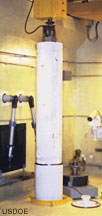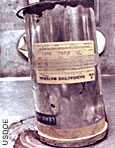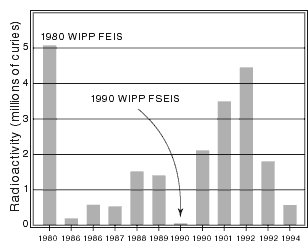The Waste
Transuranic Waste
Trans-uranic (beyond-uranium) waste is waste contaminated by elements heavier than uranium (primarily plutonium) with half-lives greater than 20 years and radionuclide concentrations more than 100 nano-curies per gram of waste. Waste with lower concentrations is defined as low-level waste (LLW). Plutonium has a half-life of 24,000 years which means that after 24,000 years, half of it will have decayed into other isotopes or elements. All transuranics are man-made alpha-emitters.
Alpha particles are relatively large, positively charged particles which are easily stopped by a piece of paper or your skin, but which are extremely dangerous if inhaled. Because of its cancer causing properties, the "acceptable" body dose of plutonium is less than one millionth of a gram, an invisible particle. Yet even this amount can cause cancer 10-30 years after it is inhaled. When filled, WIPP would contain about 13 metric tons of Plutonium-239.
The Department of Energy (DOE) sometimes refers to WIPP as a medium or low-level waste facility—describing the waste as "...rags, rubber gloves, shoe covers..." and other similar, nonthreatening objects. In fact, transuranics more closely resemble and come under the same environmental standards as high-level waste (HLW) and generally have very long half-lives. Transuranic waste also comes in many different wasteforms besides gloves and rags and the rags are often soaked in toxic solvents.
CH-TRU and RH-TRU
Transuranic waste is divided into 2 main categories by the amount of radioactivity it carries—contact-handled (CH-TRU) and remote-handled (RH-TRU) waste. CH-TRU waste is limited to a maximum  dose rate of less than 0.2 rem (200 millirem) per hour measured at the surface of the drums in which it is packed. CH-TRU accounts for most of the volume of waste going to WIPP. Most of the radioactive content of the CH-TRU waste is plutonium 238-241 and americium-241 and most of the radiation is made up of alpha particles. (Americium emits some gamma rays which penetrate the waste container walls and account for the 0.2 rem being emitted per hour.)
dose rate of less than 0.2 rem (200 millirem) per hour measured at the surface of the drums in which it is packed. CH-TRU accounts for most of the volume of waste going to WIPP. Most of the radioactive content of the CH-TRU waste is plutonium 238-241 and americium-241 and most of the radiation is made up of alpha particles. (Americium emits some gamma rays which penetrate the waste container walls and account for the 0.2 rem being emitted per hour.)
 dose rate of less than 0.2 rem (200 millirem) per hour measured at the surface of the drums in which it is packed. CH-TRU accounts for most of the volume of waste going to WIPP. Most of the radioactive content of the CH-TRU waste is plutonium 238-241 and americium-241 and most of the radiation is made up of alpha particles. (Americium emits some gamma rays which penetrate the waste container walls and account for the 0.2 rem being emitted per hour.)
dose rate of less than 0.2 rem (200 millirem) per hour measured at the surface of the drums in which it is packed. CH-TRU accounts for most of the volume of waste going to WIPP. Most of the radioactive content of the CH-TRU waste is plutonium 238-241 and americium-241 and most of the radiation is made up of alpha particles. (Americium emits some gamma rays which penetrate the waste container walls and account for the 0.2 rem being emitted per hour.)
The RH-TRU waste contains much more penetrating radiation in the form of Beta particles and Gamma rays which is the reason it has to be handled by machine in special radiation-shielded rooms called Hot Cells. (An RH-TRU waste canister is shown at left. It is a single-shell vented steel container which will hold three 55-gallon drums.) Most of the radioactive content of this waste is made up of fission products and the radionuclides are more varied: Strontium-90, Ytrium-90, Cesium-137, Barium-137, Plutonium-241, Americium-241 and Cobolt-60.
Ninety-five percent of the remote-handled waste can emit 100 rem per hour at the container surface and 5% can emit up to 1000 rem per hour. This is an enormous amount of radioactivity since a dose of 400 rem will kill 50% of all exposed people. Although RH-TRU waste accounts for only around 4% of the total waste by volume, it may account for 33-45% of the total radioactivity.
Mixed Waste
Another major category of waste is Mixed Waste. About 60-70% of the WIPP waste is Mixed Waste—radioactive waste that is also mixed with hazardous chemicals, solvents and heavy metals such as mercury and lead. Mixed waste is regulated by the New Mexico Environment Department (NMED) under the Resource Conservation and Recovery Act (RCRA). Purely radioactive waste is regulated under the Atomic Energy Act with oversight by the Environmental Protection Agency (EPA). NMED regulates the hazardous component of the waste under WIPP's Hazardous Waste Facility Permit. This permit prohibits certain types of wastes from coming to WIPP including liquid wastes, corrosive, ignitable and reactive wastes, wastes with high concentrations of PCBs, and waste that hasn't been properly characterized, among others.
Powdered Plutonium (Residues)
There is a special category of CH-TRU waste called residues. The Rocky Flats facility near Denver had the most residues, but LANL and some other sites had significant quantities as well. (The container at left contains corrosive and reactive LANL residues which have rusted completely through the top of the container.) Residues consist of soot, ash, salts, slags, graphites and other materials  contaminated with highly-concentrated amounts of plutonium. Residues vary in particle size, but much of the inventory is 'powdered'. Plutonium is most toxic when it is inhaled as small particles, yet DOE chose not to solidify most of this waste, but simply to repackage it.
contaminated with highly-concentrated amounts of plutonium. Residues vary in particle size, but much of the inventory is 'powdered'. Plutonium is most toxic when it is inhaled as small particles, yet DOE chose not to solidify most of this waste, but simply to repackage it.
Because these residues are so highly concentrated, they needed extra shielding during transportation and emplacement at WIPP so they were double packed in a steel pipe inside of a 55 gallon drum. Extra precautions had to be taken to ensure that enough fissile material didn't come together to cause a criticality event or nuclear reaction during transportation. A TRUPACT-II shipping container fully loaded with residue waste could carry more than 8 times the fissile material allowed in a normal TRUPACT-II. Though most of these residues have now been emplaced at WIPP, this is what was transported on our highways—a far cry from simple gloves and booties.
Inventory Problems

After more than 20 years of study, DOE is not even sure how much transuranic waste they actually have. In December 2000 they admitted in the National TRU Waste Management Plan, Revision 2 that of the two current databases they used, one described the total transuranic waste in the system as being 50% larger than the other. There is hardly any information in any of the databases about the hazardous component of the waste which is a serious problem if you are trying to characterize this waste on the basis of documentation. It is obvious when looking at the chart above of DOE's estimation of their RH-TRU inventory in various documents, that they are seriously confused about their waste, though it does appear that they have a lot more RH-TRU waste than WIPP is designed to hold. No wonder the National TRU Waste Management Plan stated that the uncertainty in its waste estimates "...causes the estimate of TRU waste in storage and projected to change on a frequent basis as site activities proceed."